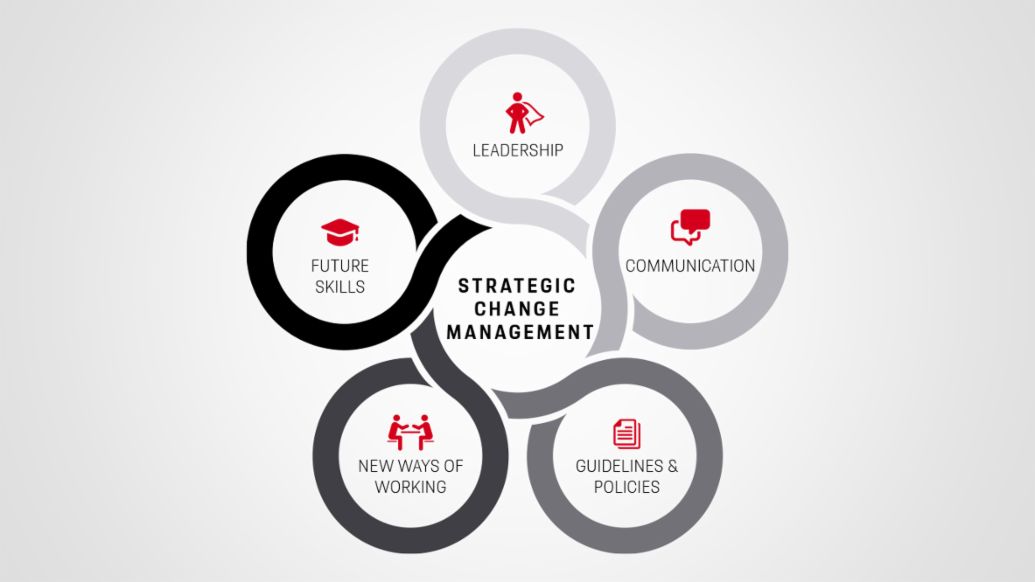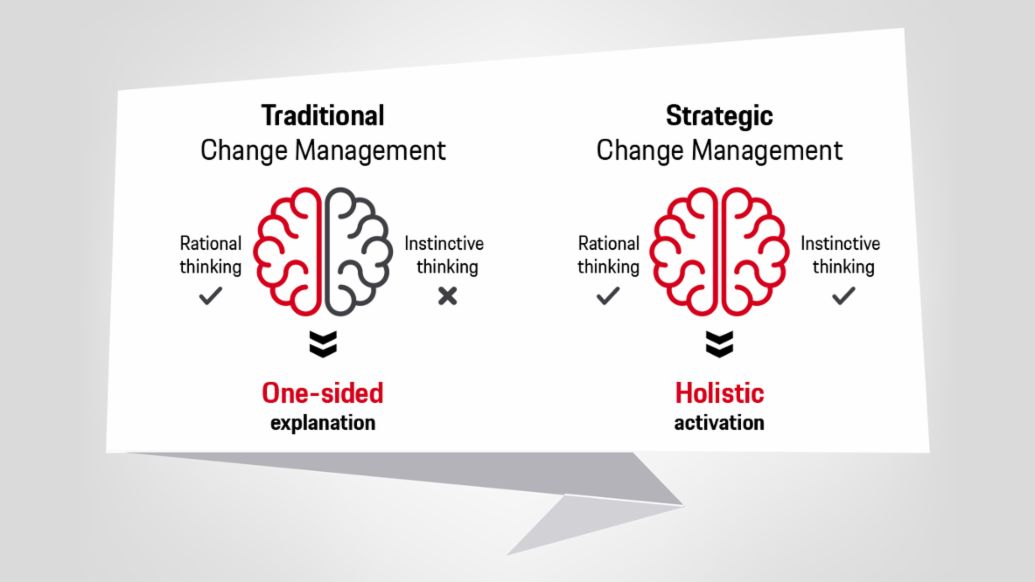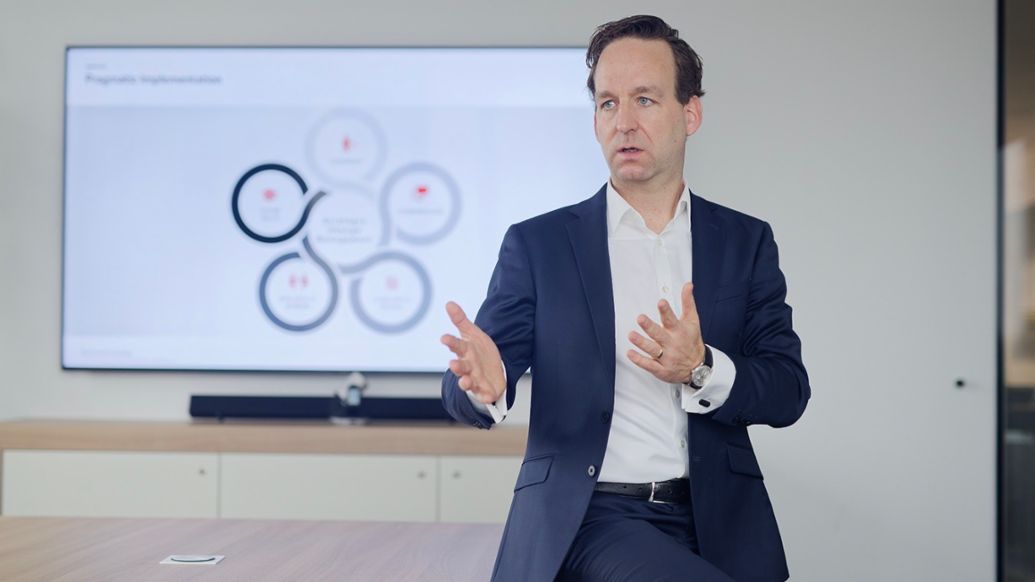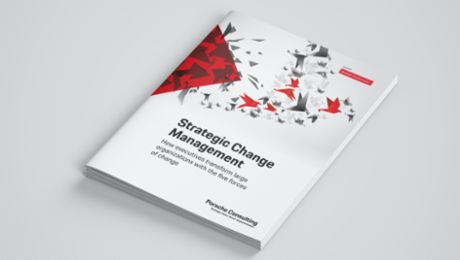Disruptive technologies. New business models. Digitalization. And not least, unforeseeable global events like the Covid-19 pandemic. The dynamics of transformation encompass all business contexts. Clearly, transformations are essential for companies to remain relevant and successful. The central challenge of this process: getting the entire workforce on board and leaving nobody behind. Those affected need to be included and activated to help drive the necessary changes, so that a motivating sense of being an important part of the transformation can grow from within.
“In 80 percent of cases, transformations fail due to—often passive—resistance on the part of employees, and simultaneously due to insufficient abilities to guide and foster change on the part of their leaders,” explains Dr. Wolfgang Freibichler, a partner at Porsche Consulting and an expert in new and successful modes of collaboration. He supports top managers in guiding their transformations. “Interestingly, one of the main reasons why transformations stall or fail has to do with a scientifically outdated understanding of how the brain works,” he continues. The expert is convinced that insights from behavioral economics make it possible “to reach people not only on rational but also instinctual levels.” Freibichler and his team of specialists have identified five forces with the ability to spur and safeguard necessary changes.

Strategic change management is the key term here. Not all of its underlying scientific insights are brand new, but hardly any are broadly applied in practice. According to Freibichler, the main difference between strategic and traditional change management is a matter of “how people are made part of the change in these special situations at work— and especially by whom.” His advice: “Getting people involved is a high-level task, and by that I mean a task for the top executives.”
Instincts are highly relevant
Freibichler underlines that in addition to addressing conscious thought, leaders need to communicate on subconscious and instinctual levels. Moreover, emotions should play an overarching role. “The key is to appeal to people not only logically, but psychologically in many ways. In other words: people forget facts, but they will always remember how they felt in a particular situation.” Modern leadership requires well-developed interpersonal skills—real empathy, applied to each and every individual.

Freibichler lists a number of major companies known for putting strategic change management into practice. Along with the insurer Axa, pharma giant Novartis, and the Otto mail-order group, Spotify and Tesla may serve as vivid examples. Elon Musk, for instance, pinpoints his visionary goal and offers an easily understandable mission to both internal and external target groups. The same can be said of Amazon founder Jeff Bezos, whose clear and concise message is to “make customers’ lives easier.” For Freibichler, this is an example of the first of the five forces: “Everyone at a company needs a clear and positive vision, and the eyes locked onto the common goal. With this in mind, leaders should enthuse and encourage their employees to drive change with passion.”
Communication is the second force for successful change management. “Here, too, it’s the top management that needs to set the tone,” says Freibichler. “As role models, top executives should introduce change with authenticity, empathy, and the necessary authority. Not just once, but continuously throughout the transformation. The message needs to be emotional in nature and is to be communicated consistently and across all channels used by the target group. And, if it is to be effective in shaping the process of change, it cannot be repeated often enough.”
Also, dialogue needs to level throughout the entire workforce and across hierarchies. Freibichler emphasizes that both realms of the brain, namely reason and instinct, need to be addressed equally. “Leaders need to lead the charge and start by speaking directly with their employees, at all hierarchies. Thereby irrational fears or reservations can be put to rest by individual dialogue. As a result, anxieties and concerns are dismantled. At the same time, direct exchange allows for leaders’ enthusiasm to take root in their employees on an emotional level.”
That being said, words have to be followed by deeds. In particular, a company’s guiding principles and KPIs need to be adapted — the third force of strategic change management. They represent the necessary organizational framework that lays the groundwork for achieving the transformation’s visionary goal. As Freibichler observes, “If the regulatory context is not adapted, positive behavioral patterns are highly unlikely to take hold.”
Setting strong examples
The fourth force of change interprets work processes in a more modern way to reflect future realities. “Existing types of collaboration should be further developed into agile work modes that break up department lines. As a result, creativity and innovation potential are unlocked, which otherwise would have been left untapped in isolating silo structures,” says Freibichler. A key concept here is New Work. “Companies are called upon to reshape their physical and digital workspaces accordingly.”
Freibichler goes on to explain that leaders are to set examples and to embrace their function as role models, preferably through “observable behavior” that abandons traditional status insignias. Exclusive and exalted executive offices, still in use at many offices today, are “power symbols of the past.” As he emphasizes, “Only when leaders display sincerity, exert transparency, and make themselves accessible can the very important exchange of views and information with everyone involved take place. Practically, this can be achieved by establishing open workspaces that are home to all hierarchies.”
The fifth force behind successful change consists of developing new and future-oriented skills. According to a survey of the largest 100 companies in Germany, only about a quarter of all employees today already possess the skills their companies will require in the future. “Sophisticated methods of improving collaboration and work atmospheres are worthless unless employees know how to put the desired transformation into practice,” Freibichler concludes. Companies therefore need to offer attractive training opportunities that put all employees in a position to “keep developing in largely self-determined and individual ways.” Standard workshops off the rack of a training provider are by no means up for the task.

A more promising approach than training programs from external providers is the establishment or expansion of strong in-house academies. “That type of forward-looking investment always pays off, not only in economic terms but also with respect to a company’s image, identity, and attractive reputation as an innovative employer.” Freibichler also argues that training programs should be integrated in everyone’s normal workdays. “These programs should not be viewed as alien, but instead become a natural part of everyday work. That is in fact the best way to foster crucial lifelong learning habits. When learning is viewed positively as a personal gain, effects are maximized.”
The expert for transformations speaks from experience when promising his clients: “When companies combine and orchestrate the five forces of change in an optimal way, they will harmonize behaviors and attitudes of their workforce with the transformative goals of their business.”
Info
Text first published in Porsche Consulting Magazin.


-2.jpg/jcr:content/STR_HydrogenD328%20(1)%202.jpg)


